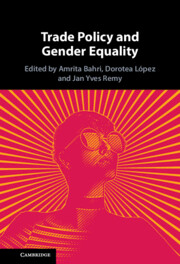Contents
Part IThe WTO and Gender Equality
2Gender-Responsive WTO: Making Trade Rules and Policies Work for Women
4Global Economic Governance and Women: Why Is the WTO a Difficult Case for Women’s Representation?
Part IICurrent Issues in Gender Equality and Trade Policies
5Women in the LDCs: How to Build Forward Differently for Them
6Gender-Inclusive Governance for e-Commerce, Digital Trade, and Trade in Services: A Look at Domestic Regulation
7Setting Up the Table Right: Women’s Representation Meets Women’s Inclusion in Trade Negotiations
8The Importance of Gender-Responsive Standards for Trade Policy
9Mainstreaming Gender in Investment Treaties and Its Prevailing Trends: The Actions of MNEs in the Americas
10Gender Approaches in Regional Trade Agreements and a Possible Gender Protocol under the African Continental Free Trade Area: A Comparative Assessment
11Leave No Woman Behind: Gender and Trade Policy in CARICOM SIDS
12South America’s Leadership in Gender Mainstreaming in Trade Agreements
13Gender Mainstreaming in Trade Agreements: Best Practice Examples and Challenges in the Asia-Pacific

